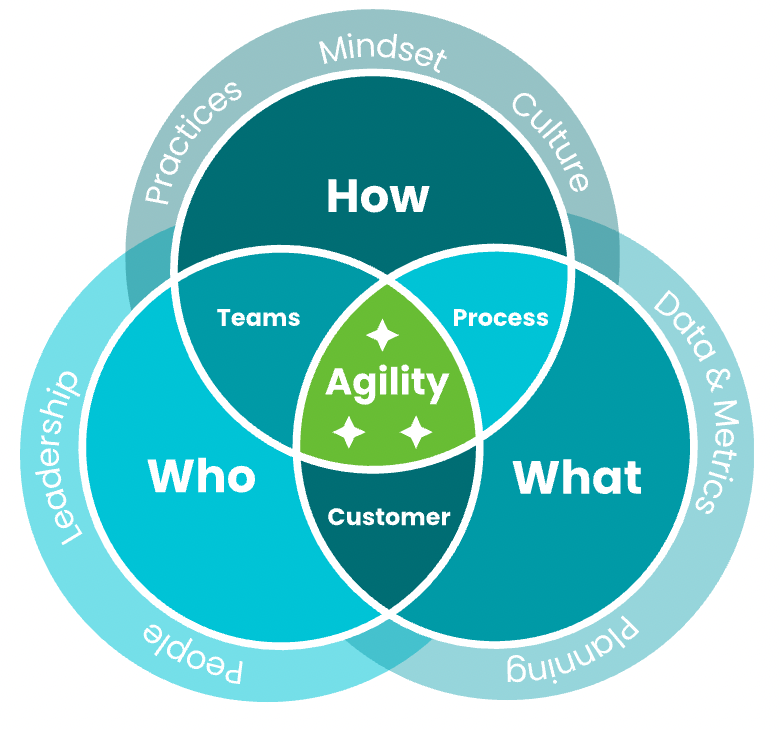
The Agile
Marketing Credo

“Agile marketing isn’t just Agile applied to marketing. It’s a complete operating system, purpose-built for the complexity, creativity, and cross-functional chaos of modern marketing teams. Done right, it doesn’t just improve efficiency. It transforms influence, credibility, and outcomes across the entire business.”
- Andrea Fryrear, CEO of AgileSherpas
Agile Marketing Is Broken.
Here’s How We Fix It.
Ever since the internet roared onto the scene several decades ago, marketers have been struggling. Practically overnight we went from managing a handful of channels via clearly defined roles, to juggling an avalanche of acronyms with a system full of silos.
Think for a moment about the pre-digital marketing world. I know it feels like eons ago, but consider what annual planning might have been like when you could count your whole list of possible tactics on two hands.
There was no SEO, no CVR. There was no obsessing over CTR or maximizing ROAS. Social media marketing didn’t exist, much less the feeling that we have to be publishing everywhere everyday.
Then, in the span of just a few years, we had to not only build websites, but constantly keep updating them. Here we discovered how hard it is to work with other functions, and we began to get a taste for the disdain with which marketing would be treated as we tried to make our way in this new, digital world.
And of course, building the website wasn’t enough. Once those blasted things existed we somehow had to get people to come to them. The complex and convoluted world of SEO taught us a healthy fear of the platforms like Google who controlled much of our fate, but shared little of their rationale or data.
And then came social media. Originally ridiculed as a waste of time and money for “serious” organizations, these new channels quickly proved that marketers would need to take emerging opportunities seriously or risk falling irrevocably behind.
For the marketers living through this turbulent period, it felt like going from peacefully paddling a canoe across a calm lake to struggling against a hurricane in a leaky vessel weighed down by multiple anchors.
In the modern marketing era, many of us have chafed against the constant choppiness of the way our teams got things done.
It’s too hard, too messy, and too unpredictable.
It thrives on individual heroics, excessive overtime, and unreasonable expectations.
Personally, I wanted to find a better way. And eventually, I discovered Agile ways of working.
Agile marketing was supposed to fix everything: faster campaigns, better collaboration, improved outcomes.
But somewhere along the way, the promise got lost.
Today, “Agile” in marketing often means a board full of overdue tasks, rushed standups that most people skip, and frustrated teams still buried under silos, unclear goals, and chaotic work.
This isn’t Agile. It’s frenetic activity with a new name—and it’s failing marketers at the moment they need it most.
Because AI’s upheaval of the marketing function makes the craziness of the digital revolution look like a calm Sunday stroll through the park. Marketers cannot possibly survive this era without real agility.
So it’s time to take back Agile and make it work for marketing again.
The Real Problem: Marketing Isn’t Built to Be Agile
Agile has a great track record in software and product development. It cut delivery times dramatically, producing “twice the work in half the time,” as Jeff Sutherland has famously documented.
But traditional Agile frameworks were tailor made for these very specific use cases.
They were not designed for marketing’s unique flavor of complexity.
Consider just some of the nuances that marketing orgs deal with:
-
Despite thousands of pieces of martech available to us, even the most sophisticated marketing teams struggle to get accurate attribution or measurable ROI. Think of the biggest, fanciest ad campaign you’ve ever seen. Chances are nobody has any idea whether or not it actually worked.
-
The most painful current example of this is marketers’ inability to experiment with advanced AI functionality without support from IT, but this is just the latest in a long line of frustrating roadblocks. Whether it’s navigating legal and compliance or the maddening process of collecting coherent stakeholder feedback, marketers can rarely act with complete independence.
-
As the function has fragmented and its intricacies have increased, many marketing colleagues work side by side with only a cursory understanding of what their teammates do all day. This divide makes it easy to point fingers when delays inevitably creep in; “that other team” is behind, not us!
-
In the absence of clear attribution or measurement, the amount of stuff we produce often becomes a proxy for marketing’s value. We get evaluated on the number of campaigns, pieces of collateral, or social media posts we produce, which traps us in a cycle of always needing to do more to justify our budget. But who needs to sleep anyway?
-
As a result of all of the above (and other challenges too numerous to list here), marketers’ status falls to that of short order cook. We spend our days making landing pages, building slides, or updating sales enablement materials – pretty much whatever we’re asked to do. Nobody cares if there’s a meaningful, coherent strategy as long as the thing they asked for shows up on time.
While there are clear parallels to the challenges that showed up in software development and led to the creation of Agile frameworks in the late 1990s and early 2000s, that doesn’t mean that what worked there will work for marketers.
Applying existing Agile frameworks out of the box doesn’t transform marketing—it distorts it.
This is why you often hear things like, “We tried Agile marketing, but it just didn’t work for us.” Or, “We started doing Scrum but gave up because it didn’t seem like it was helping.”
Taking software development frameworks and applying them to marketing without taking into account any of the above nuances is a recipe for failure.
But if you’re getting guidance from someone who’s never worked in marketing, that’s what’s happening. Trying to teach someone how to use Agile frameworks in a discipline you’ve never worked in is a terrible idea. I’ve spent a decade in the Agile marketing world now, and I am completely certain about this.

Agile Marketing Is Its Own Discipline
The reason that Agile marketing needs to be led by marketers is that real Agile marketing isn’t a knock-off of tech team tactics. It’s a strategic operating system built around three essential questions:
- How do we work? (Mindset, practices, culture)
- What do we work on? (Prioritization, data, planning)
- Who does the work and for whom? (Teams, leadership, customers)
When the How, What, and Who align, marketing agility emerges—not as a buzzword, but as a business advantage.
The Agile Marketing Operating System: Only at the center of How, What, and Who does true agility live.
An Agile coach or trainer who comes from a non-marketing background might be able to help with a few of these areas, but their expertise will fail quickly. Maybe they can tell you what a standup is or how a Kanban board typically works, but the nuance will get them every time.
Should the agency join our standup? How about planning? If they aren’t in any of those meetings, how can we be sure they’re doing what they should? But if they join all the meetings, that’s going to eat up a bunch of our retainer.
Does each marketing function need their own kanban board and/or backlog? If they’re separate, how can we help shared resources prioritize their work? If they’re combined, won’t the sheer volume of tasks become overwhelming?
If we tell sales that we can’t commit to delivering some of their requests in an upcoming sprint, they’ll just go and build stuff themselves. Then we can’t track it or make sure it’s on message. How are we supposed to protect our capacity if we can’t say no to anything ever?
I’m a career marketer. I would never presume to try and coach a team of developers on how to use Agile. Let’s give marketers that same level of respect.
What Most Organizations Are Doing Wrong
Some of you reading this may be thinking that you really did try Agile marketing, and it really didn’t work for you. I’ve been asked many times whether I think all marketing teams can or should be Agile, and it’s always because people believe there must be some situations where Agile just isn’t feasible.
Here’s the real talk about that: if you know exactly what you’re going to be doing for the next six months – and I mean exactly, down to the week you’ll be doing something and what it’s going to look like and how long it’ll take you to get approval on it – then Agile probably won’t help you that much.
But be real with me in exchange: how many teams does that apply to, especially right now?
Agile was made to handle rapid feedback in a constantly changing environment. Which means it applies to pretty much all of us now.
If you don’t know exactly what’s going to work, or which channel will be the top performer, or how long it’ll take a stakeholder to get back to you, or which messaging will resonate with your ICP the best, or any other variable in the infinite list of marketing unknowns, then you need Agile marketing in your life.
If you honestly think you tried it and didn’t get results, here’s what’s probably happening:
-
Status meetings become “standups” or “huddles,” but they still take 60 minutes and nobody leaves with a revised plan for how they’re going to spend their next working day. “Sprint reviews” are just thinly veiled complaint calls, where stakeholders rip apart the latest deliverables but don’t give guidance on how to improve next time. What fun. Sign me up.
-
If you get the same old annual plan that you’ve been getting for the last 10 years and try to break it down into sprints, it’s going to suck. You can’t test, learn, and iterate around a 12-month plan that’s already been set in stone. You’ve got to have some flexibility somewhere, or what’s the point of learning fast?
-
Agile teams, especially Agile marketing teams, are always learning. But if you don’t allow them to apply their new knowledge strategically, and instead insist they keep cranking out collateral on demand, that insight is worthless.
-
Agile is for everybody, and that includes managers and execs. They have to plan differently, manage differently, evaluate people differently. If they don’t, Agile marketing’s impact will be stunted. Likewise, you need to be measuring as much as possible. If you’re relying on gut feel or squishy, unreliable metrics, it’s far too easy for people to insist you prioritize their one-pager. After all, how can you prove a strategic project would really make a bigger impact?
-
I don’t want to insult colleagues here, but the truth is that marketers can’t blindly follow the advice of just anybody with “the right” acronym after their name. And if somebody comes to you from the big, fancy, consulting firm you’ve already got on retainer and tells you they “know Agile,” get really skeptical really fast. All these people are probably very smart and very skilled in their own field. But if that field does not include hands-on experience in both marketing AND Agile ways of working, you’re better off figuring it out yourself.
Agile marketing is not simply “Agile for marketers.” It’s a system-level redesign of how marketing creates value.
Marketing systems are complicated, and if you’re taking advice from someone who’s never tried working inside one, much less changing one from end to end, you’re setting yourself up for a world of hurt.
The Solution: The Agile Marketing Operating System™ + The Agile Marketing Edge™
Ok, that’s probably enough of articulating the problem. Let’s get focused on what to do about it.
First of all, here’s why you should listen when I give advice about this: AgileSherpas didn’t just borrow Agile from software. We built Agile marketing.
- We co-created the world’s first internationally accredited certification in Marketing Agility alongside the International Consortium for Agile (ICAgile). We were the first to deliver that course back in 2018, and since then we’ve certified thousands of marketers around the world.
- I personally authored the foundational texts on the subject via my two books, Mastering Marketing Agility and Death of a Marketer, not to mention we’ve published over 350 in-depth articles, case studies, and how-to guides that we’ve made available for free.
- The AgileSherpas team has delivered Agile marketing transformation across verticals—from B2B tech to higher ed to health care. Our clients have been recognized via the Agile Business Consortium’s annual awards, and our champions have been promoted and praised for the successful outcomes they’ve helped drive for their organizations.
- We’ve developed an Agile Marketing Competency for the Scaled Agile Framework (SAFe), to help bring this internationally recognized scaling framework to the marketing function.
- From ICAgile to the Scrum Alliance to SAFe to the Agile Business Consortium to the Agile Alliance to the Business Agility Institute, our Sherpas have collaborated with the worldwide Agile community to develop and steer the Agile marketing movement for a decade.
But, if I’m sticking with the real talk, recently we’ve dropped the ball.
For several years we were synonymous with the term Agile marketing, but we let the category drift away from us. The language got commoditized, watered down by tool vendors and management consultants who wanted to use it to sell their own stuff.
That can’t happen anymore.
The stakes are too high and the marketing function is too important to allow these concepts to continue being co-opted.
AgileSherpas is reclaiming the term Agile marketing, and we’re adding additional clarity to ensure that marketers get access to real Agile ways of working that are custom-made for the critical work they do.
That’s why we created the Agile Marketing Operating System™, the only holistic framework for sustainable, scalable agility in marketing. It’s a realistic, pragmatic way of getting marketing work done in the age of AI, paired with a cost-effective support system called The Edge™. It’s built to serve marketers in the midst of the insane realities of their roles, and costs about what you’d pay to have your whole team in Jira (plus it’s a lot more fun to use ;)
Exploring the Agile Marketing Operating System (AoS)
The AoS was built off the difficult realization that Agile frameworks alone aren’t enough to transform marketing. Our clients needed to adjust their leadership styles, their planning mechanisms, their cultures, and more, and off the shelf Agile isn’t made to tackle those challenges.
Instead of trying to re-explain this to every client and every student in a new way, we’ve put it into an easy-to-follow diagram (here it is again for your reference):

You’ll notice that agility – the real kind, not “we move really fast” or “we change our minds all the time” or “we don’t do annual planning anymore” – lives at the center of Who, What, and How. We achieve it by shifting across all three dimensions.
More specifically:
-
Leadership: Across the org chart, people need to adjust their daily behavior. Leaders and managers can’t derive value in their roles by maintaining a strangle hold on every piece of work that’s produced. They have to become empowering heat shields, enabling and protecting their teams so they can focus on important, value-adding work. This requires retraining and coaching, and sometimes new hires, to get the right people into leadership positions.
People: Likewise we need the right people with the right skills and attitudes in place. But we can’t expect them to magically acquire new knowledge when they’re locked in meetings for 9 hours a day. We have to be prepared to support our people with education, space, and reasonable expectations.
Teams: What’s a team? Who’s on it? Where does AI fit? Are they permanent or temporary? How many should we have, and how big should they be? These are critical questions that need to be explicitly addressed and repeatedly reviewed. Teams are the heartbeat of modern marketing, and thanks to AI even small ones can do more than ever.
Customer: Understanding who your customers are – both internal and external – and how you’re expected to balance their demands is essential for marketing to succeed. Otherwise you’ll spend all your time catering to internal customers, who have the ability to Slack you or walk up to your desk and demand your attention, instead of external customers, who aren’t normally in the building but who ultimately provide the revenue that keeps your company running.
-
Customer: Customer centricity overlaps with What, because it should always inform what marketers are working on. If we can’t draw a clear line from daily activity to customer value, then we’re probably doing the wrong stuff.
Planning: Building a single annual plan for marketing and expecting it to hold for 12 months is laughable in the modern era. Entire new platforms emerge and attract millions of users in a matter of weeks; we have to be prepared to act when that happens. But, on the other hand, we can’t just flail haphazardly without any set plan whatsoever. A disciplined quarterly cadence, complimented by 2-3 week backlog refinement sessions, supports most marketing teams in executing the right work at the right time. Sadly, outside the AoS, few are able to implement and sustain this cycle.
Data & Metrics: Accurate, trustworthy data is essential, not only for decision making, but to keep marketing insulated from outside insistence that their ideas should prevail. AI has made the “everybody can be a marketer” problem even worse, so we need clear data and metrics at hand to prove that our role is delivering, and we have the strategic vision to steer it into the future.
Process: The world of marketing is simply moving too fast for us to waste time chasing down status updates or doing wasteful rework. Our processes need to be a superpower, not an anchor dragging us down. Here’s where we can borrow most heavily from existing Agile tools, but we need not heedlessly copy and paste.
-
Teams: Teams is the point where the Who and How intersect, because the way people work together matters just as much as who they are. Clear documentation, handoff procedures, and supporting tools are all needed to equip teams to perform at their highest level.
Process: Likewise process is the intersection between What and How. Agile frameworks and their corresponding practices allow marketers to move quickly and yet maintain focus on the most critical activities. In a profession where things change daily, and yet core principles are eternal, maintaining this balance is absolutely essential.
Practices: It should be easy to step into a marketing team and understand how things get done. Systematic, repeatable, well-documented practices help new team members get up to speed quickly, and that includes integrating AI team members. Once again we draw heavily on Agile practices like backlogs and WIP limits here, but adapt them to apply to marketing work.
Mindset: The AoS centers on several key concepts, also known as an Agile mindset. Each installation of the operating system tailors the mindset to align with the organization where it will be used, but there are some core components that can’t shift. Rapid iteration and experimentation, progress over perfection, and ruthless prioritization are just a few of the key tenets.
Culture: While mindset refers to a few core ideas, culture covers a broader range of behaviors and beliefs. These become the DNA of a team and organization, the default way of behaving in any situation. Of all the pieces of the AoS this one takes the longest to change, but is the most instrumental in ensuring the other changes will be permanent.
The Agile Marketing Edge
One final thing that AgileSherpas intent on changing is the way we help marketers. Just like traditional Agile frameworks haven’t been the best fit for marketers, the traditional ways of applying those frameworks aren’t working as well as they once did.
Intensive multi-day workshops can be useful in certain contexts, but they aren’t right for everybody or every situation. And yet those have traditionally been the starting point for an Agile rollout.
Then you coach the Agile teams for months, maybe years. It’s a long, labor-intensive process, whether you rely on an external consultant or hire in-house roles.
We started asking ourselves why it had to be this way, and couldn’t come up with a good answer.
So we threw out the old playbook, took a hard look at the new AI-enabled world, and came up with a brand new way to support Agile marketers.
We call it The Edge, and it’s a monthly or annual subscription that combines all the pieces a team needs to keep its Agile Operating System humming. It includes:
- Unlimited access to our SherpaBot, which we’ve trained to act like one of our coaches. It’s like having a Sherpa in your pocket 24-7
- 50 micro-learning courses (and counting!), each targeted at a common Agile marketing issue or pain point
- 3 full certification-level courses, Agile Marketing Fundamentals, Agile Marketing Leadership, and Business Agility Fundamentals, that you and your team can work through at your own pace
- 2 hours per month of live coaching with a human member of the AgileSherpas team that you can book whenever you want
- Access to weekly workshops on a wide array of topics, such as Facilitating Agile Meetings that Don’t Suck, Running an AI Clarity Sprint, Managing Unplanned Work, and more. You can join 1 of these 90-minute sessions each quarter for free, and add on others for a fee if you like.
Our goal is to get you all the support you need, without breaking your budget. We’re also rolling out smaller offerings for teams (and individuals) that are just getting started, because we want every marketer on every team in every organization to enjoy the benefits of agility.
New courses like Personal Agility for Marketers, Agile Marketing for Executives, and Agile Marketing for Managers will equip individuals to leverage Agile tools on their own, so they can enjoy their work and accelerate their career.
Focused team-level offers like Save my Standup and Revive my Review will offer laser-focused support for teams that are struggling.
Take Our Free Marketing Agility Assessment
Find out where your biggest operational weaknesses lie, and where to lean into your strengths.
In just 10 minutes you'll get a holistic view across the 9 dimensions of agility: practices, mindset and culture, data, planning, leadership, people, teams, process, and customer centricity.
.png?width=1000&height=1100&name=Homepage%20Revamp%20Images%20-%20Marketing%20Agility%20Assesment%20(1).png)

It’s Time to Rebuild Marketing the Right Way
As I hope is clear, we’re serious about reclaiming not only the phrase “Agile marketing,” but the way marketers put it into practice.
This is not swapping out the word “developer” for the word “marketer” in the Scrum guide.
It is not copying and pasting the same strategy deck that was used at the last client and telling you it’s customized for your context.
This a call to arms and a call to action.
For any marketer who’s experienced real agility and won’t go back, for any leader who knows Agile keeps their teams happier and more productive, for any marketing exec who’s tired of taking orders and not having a seat at the table – let’s take back Agile marketing.
If your “Agile marketing” isn’t driving impact across customer experience, performance metrics, and team engagement, it’s not Agile. And it’s not your fault.
Let’s fix that—together.
